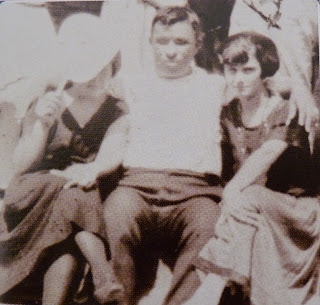Sur le Borde de l'Eau sounds to my ears like a traditional song that could originate back in France - with its modal tune, and tragic and possibly allegorical narrative about the loss of a ring and the death of a handsome young sailor. Gaspard's guitar accompaniment is no more than a rudimentary strum, although he creates quite an interesting and pleasing effect by ending each section on a major chord.4,5
Un jour, je me promène, tout le long de mon jardin,
Tout le long de mon jardin sur le bord de l'île,
Tout l'long de mon jardin sur le bord de l'eau,
Sur le bord d'un vaisseau.Je m'aperçois d'une barge, de trente matelots,Je m'aperçois d'une barge, de trente matelots,De trente matelots sur le bord de l'île,De trente matelots sur le bord de l'île,Sur le bord d'un vaisseau.Les deux plus jeunes des trente,Chantaient-z-une chanson,Chantaient une chanson sur le bord de l'île,Chantaient une chanson sur le bord de l'eau,Sur le bord d'un vaisseau.La belle chanson qu' tu chantes, j'aimerais la savoir,La belle chanson qu' tu chantes, j'aimerais la savoir,J'aimerais la savoir sur le bord de l'île,J'aimerais la savoir sur le bord de l'eau,Sur le bord d'un vaisseau.Ma belle, rentrez dans ma barge, je vous la montrerai,Ma belle, rentrez dans ma barge, je vous la montrerai,Je vous la montrerai sur le bord de l'île,Je vous la montrerai sur le bord de l'eau,Sur le bord d'un vaisseau.La belle fut embarquée et s'est mise à pleurer,Elle se mise a pleurer sur le bord de l'île,Elle se mise a pleurer sur le bord de l'eau,Sur le bord d'un vaisseau.
 |
| Alcide Gaspard |
It's similar to later French recordings, such as "La Fille aux Chansons" or "Marion s'y Promène" and "Le Bateau Chargé de Blé", in which deal with the same basic story; a girl is lured on board a ship by a captain who has designs upon her. In some forms, she escapes by cunning; in others she comes to a ghastly end. Given the line "sur le bord d'un vaisseau", some have suggested the last word could be "maison" or "ruisseau" which would have him reference the "edge of the stream". Gaspard's use of language differed than most of the Cajun recordings of the time. The majority of settlers in Avoyelles, like Evangeline, Pointe Coupee, and the upper part of St. Landry were all Creole French, most descendants of former French soldiers who had served at the Forts in IL (Upper LA), Arkansas, and Mobile. The French spoken in these parts is still, for the most part, slightly different from the French spoken by the Acadians.6
One day, I walked along my garden,
All along my garden on the edge of the island,
All along my garden on the edge of the water,
On the edge of a ship.I see a boat of thirty sailors,I see a boat of thirty sailors,Thirty sailors on the edge of the island,Thirty sailors on the edge of the island,On the edge of a ship.The two youngest of the thirty,Sang a song,Sang a song on the edge of the island,Sang a song on the edge of the water,On the edge of a ship.The beautiful song they sang, I wanted to know,The beautiful song they sang, I wanted to know,I'd like to know on the edge of the island,I'd like to know on the edge of the water,On the edge of a ship.My beauty, get into my boat, I'll show you,My beauty, get into my boat, I'll show you,I'll show you on the edge of the island,I'll show you on the edge of the water,On the edge of a ship.She boarded and she started to cry,She started crying on the edge of the island,She started crying on the edge of the water,On the edge of a ship.
Gaspard died in 1937, buried near his home in Plaucheville, with his music almost forgotten to time. "Sur Le Borde De L'eau" was recently featured on the 2014 soundtrack of the HBO Television series True Detective, bringing Gaspard's musical endeavors into the mainstream public for the first time. According to music producer, Christopher King, he states:
I've heard the song "Sur Le Borde De L’eau" by Blind Uncle Gaspard as being one of the saddest records ever recorded.
Music journalist Amanda Petrusich discusses the song in her book about collecting 78 rpm records, Do Not Sell At Any Price. The song was among those featured in a 2015 interview with Petrusich on the NPR program, Fresh Air:
I think this record contains a particular quality that i sometimes hear in pre-war American music, ...that i have failed to find in almost any other genre or time period which is this sort of unspeakable yearning. Of course, with this record, he's singing in French, and a French that's speckled with Creole idioms.
Whatever he's communicating, it's extra musical. It's something in the tone of his voice, the way that he's plays the guitar. It's extraordinarily sad. When I try to imagine the circumstances that would lead someone to sing this way, it's devastating.3
The song was resurrected by the band Feaufollet. Interest in Gaspard and his unsung music career have grown in significant popularity since the recent rediscovery of his music; as is featured on rare Cajun recordings re-released gradually into the Millennium.1
- https://en.wikipedia.org/wiki/Blind_Uncle_Gaspard
- Discussion with Malcolm Douglas
- The Lost Bard of Louisiana By KIRBY RAMBIN. (http://kedm.org/post/lost-bard-louisiana#stream/0)
- http://www.mustrad.org.uk/reviews/e_cajun.htm
- https://oldtimeparty.wordpress.com/2012/08/07/early-american-cajun-music/
- Discussions with Fr. Jason Vidrine
- Lyrics by 'pitipoid'
Release Info:
G05 NO-122 Natchitocheo (French Town) | Vocalion 5333
G06 NO-123 Sur Le Borde De L'Eau (On The Riverside) | Vocalion 5333
Find:
G05 NO-122 Natchitocheo (French Town) | Vocalion 5333
G06 NO-123 Sur Le Borde De L'Eau (On The Riverside) | Vocalion 5333
Find:
John Bertrand / Blind Uncle Gaspard / Delma Lachney Early American Cajun Music (Yazoo, 1999)
Blind Uncle Gaspard, Delma Lachney – On The Waters Edge (Mississippi, 2014)





















